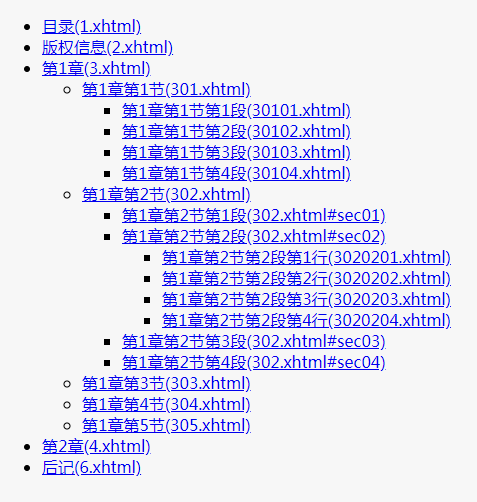根据返回数据, 迭代数组, 构造HTML结构

首先需要引入jQuery哈!
1. 要求用下面的格式制作目录, 结构如下:
<ul>
<li>xxxx</li>
<li>xxxx</li>
<ul>
<li>xxxx</li>
<li>xxxx</li>
<ul>
<li>xxxx</li>
<li>xxxx</li>
</ul>
</ul>
</ul>
2. 要求带锚点的, 要使用父节点ID+锚点做为链接1. 后台返回的数据:
const newDirList = [ { "catalogId": 1, "catalogFid": 0, "catalogName": "目录", "child": [], "anchor": "" }, { "catalogId": 2, "catalogFid": 0, "catalogName": "版权信息", "child": [], "anchor": "" }, { "catalogId": 3, "catalogFid": 0, "catalogName": "第1章", "child": [ { "catalogId": 301, "catalogFid": 3, "catalogName": "第1章第1节", "child": [ {"catalogId": 30101, "catalogFid": 301, "catalogName": "第1章第1节第1段", "child": [], "anchor": ""}, {"catalogId": 30102, "catalogFid": 301, "catalogName": "第1章第1节第2段", "child": [], "anchor": ""}, {"catalogId": 30103, "catalogFid": 301, "catalogName": "第1章第1节第3段", "child": [], "anchor": ""}, {"catalogId": 30104, "catalogFid": 301, "catalogName": "第1章第1节第4段", "child": [], "anchor": ""} ], "anchor": "" }, { "catalogId": 302, "catalogFid": 3, "catalogName": "第1章第2节", "child": [ {"catalogId": 30201, "catalogFid": 302, "catalogName": "第1章第2节第1段", "child": [], "anchor": "sec01"}, {"catalogId": 30202, "catalogFid": 302, "catalogName": "第1章第2节第2段", "child": [], "anchor": "sec02"}, {"catalogId": 30203, "catalogFid": 302, "catalogName": "第1章第2节第3段", "child": [], "anchor": "sec03"}, {"catalogId": 30204, "catalogFid": 302, "catalogName": "第1章第2节第4段", "child": [], "anchor": "sec04"} ], "anchor": "" }, { "catalogId": 303, "catalogFid": 3, "catalogName": "第1章第3节", "child": [], "anchor": "" }, { "catalogId": 304, "catalogFid": 3, "catalogName": "第1章第4节", "child": [], "anchor": "" }, { "catalogId": 305, "catalogFid": 3, "catalogName": "第1章第5节", "child": [], "anchor": "" } ], "anchor": "" }, { "catalogId": 4, "catalogFid": 0, "catalogName": "第2章", "child": [], "anchor": "" }, { "catalogId": 6, "catalogFid": 0, "catalogName": "后记", "child": [], "anchor": "" } ]
2. javaScrip:
1 function genLi(name, catalogId, anchor, catalogFid) { 2 return ` 3 <li> 4 <a href="${anchor?catalogFid:catalogId}.xhtml${anchor?'#'+anchor:''}">${name}(${anchor?catalogFid:catalogId}.xhtml${anchor?'#'+anchor:''})</a> 5 </li> 6 `.trim(); 7 } 8 function loopArray (arr) { 9 let $ul = $('<ul>'); 10 arr.forEach(function(v){ 11 let $li = $(genLi(v.catalogName, v.catalogId, v.anchor, v.catalogFid)); 12 $ul.append($li); 13 if (v.child && v.child.length) { 14 $ul.append(loopArray(v.child)); 15 } 16 }); 17 return $ul.get(0).outerHTML; 18 } 19 loopArray(newDirList);
3. 生成出的HTML代码:
<ul> <li> <a href="1.xhtml">目录(1.xhtml)</a> </li> <li> <a href="2.xhtml">版权信息(2.xhtml)</a> </li> <li> <a href="3.xhtml">第1章(3.xhtml)</a> </li> <ul> <li> <a href="301.xhtml">第1章第1节(301.xhtml)</a> </li> <ul> <li> <a href="30101.xhtml">第1章第1节第1段(30101.xhtml)</a> </li> <li> <a href="30102.xhtml">第1章第1节第2段(30102.xhtml)</a> </li> <li> <a href="30103.xhtml">第1章第1节第3段(30103.xhtml)</a> </li> <li> <a href="30104.xhtml">第1章第1节第4段(30104.xhtml)</a> </li> </ul> <li> <a href="302.xhtml">第1章第2节(302.xhtml)</a> </li> <ul> <li> <a href="302.xhtml#sec01">第1章第2节第1段(302.xhtml#sec01)</a> </li> <li> <a href="302.xhtml#sec02">第1章第2节第2段(302.xhtml#sec02)</a> </li> <ul> <li> <a href="3020201.xhtml">第1章第2节第2段第1行(3020201.xhtml)</a> </li> <li> <a href="3020202.xhtml">第1章第2节第2段第2行(3020202.xhtml)</a> </li> <li> <a href="3020203.xhtml">第1章第2节第2段第3行(3020203.xhtml)</a> </li> <li> <a href="3020204.xhtml">第1章第2节第2段第4行(3020204.xhtml)</a> </li> </ul> <li> <a href="302.xhtml#sec03">第1章第2节第3段(302.xhtml#sec03)</a> </li> <li> <a href="302.xhtml#sec04">第1章第2节第4段(302.xhtml#sec04)</a> </li> </ul> <li> <a href="303.xhtml">第1章第3节(303.xhtml)</a> </li> <li> <a href="304.xhtml">第1章第4节(304.xhtml)</a> </li> <li> <a href="305.xhtml">第1章第5节(305.xhtml)</a> </li> </ul> <li> <a href="4.xhtml">第2章(4.xhtml)</a> </li> <li> <a href="6.xhtml">后记(6.xhtml)</a> </li> </ul>




 浙公网安备 33010602011771号
浙公网安备 33010602011771号